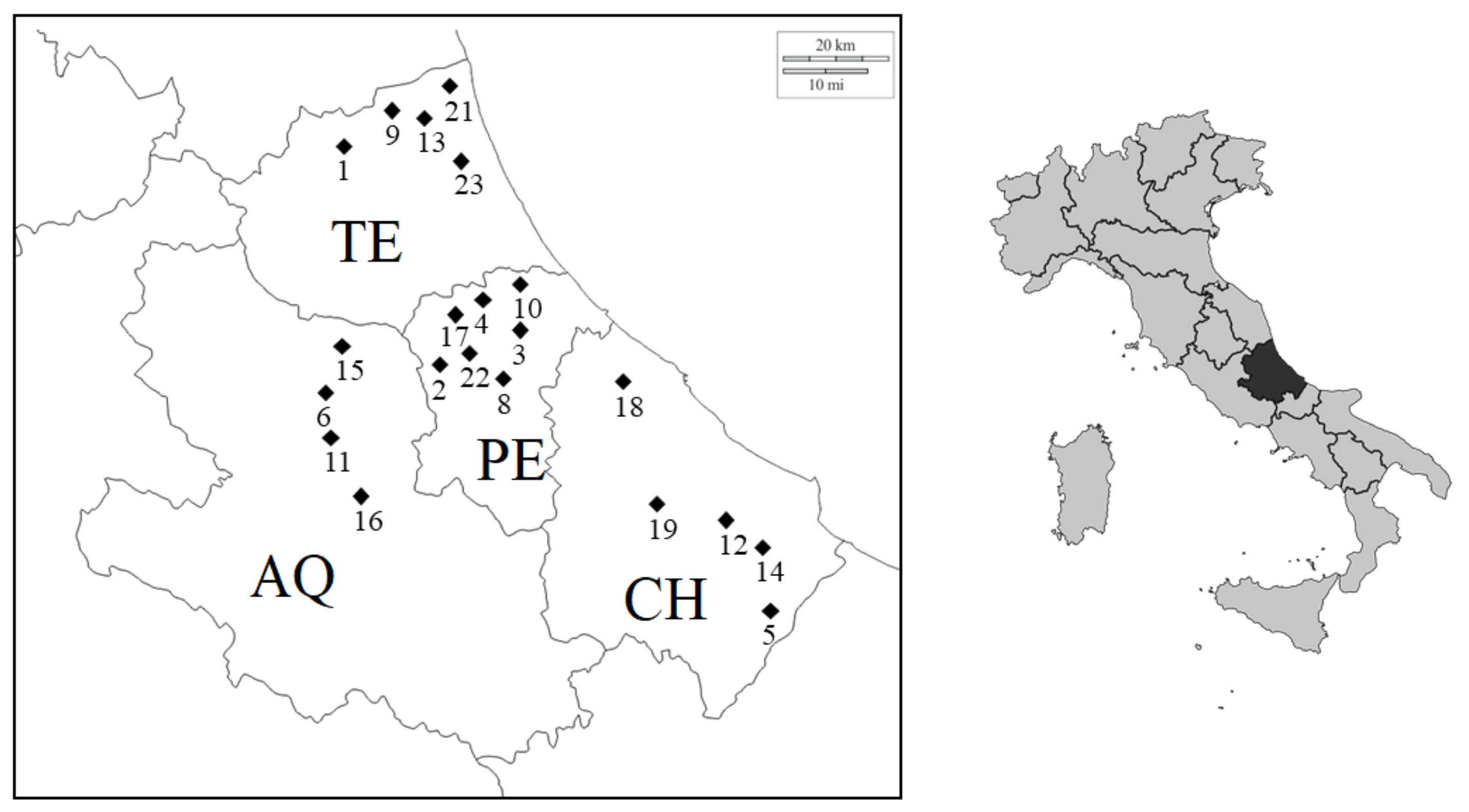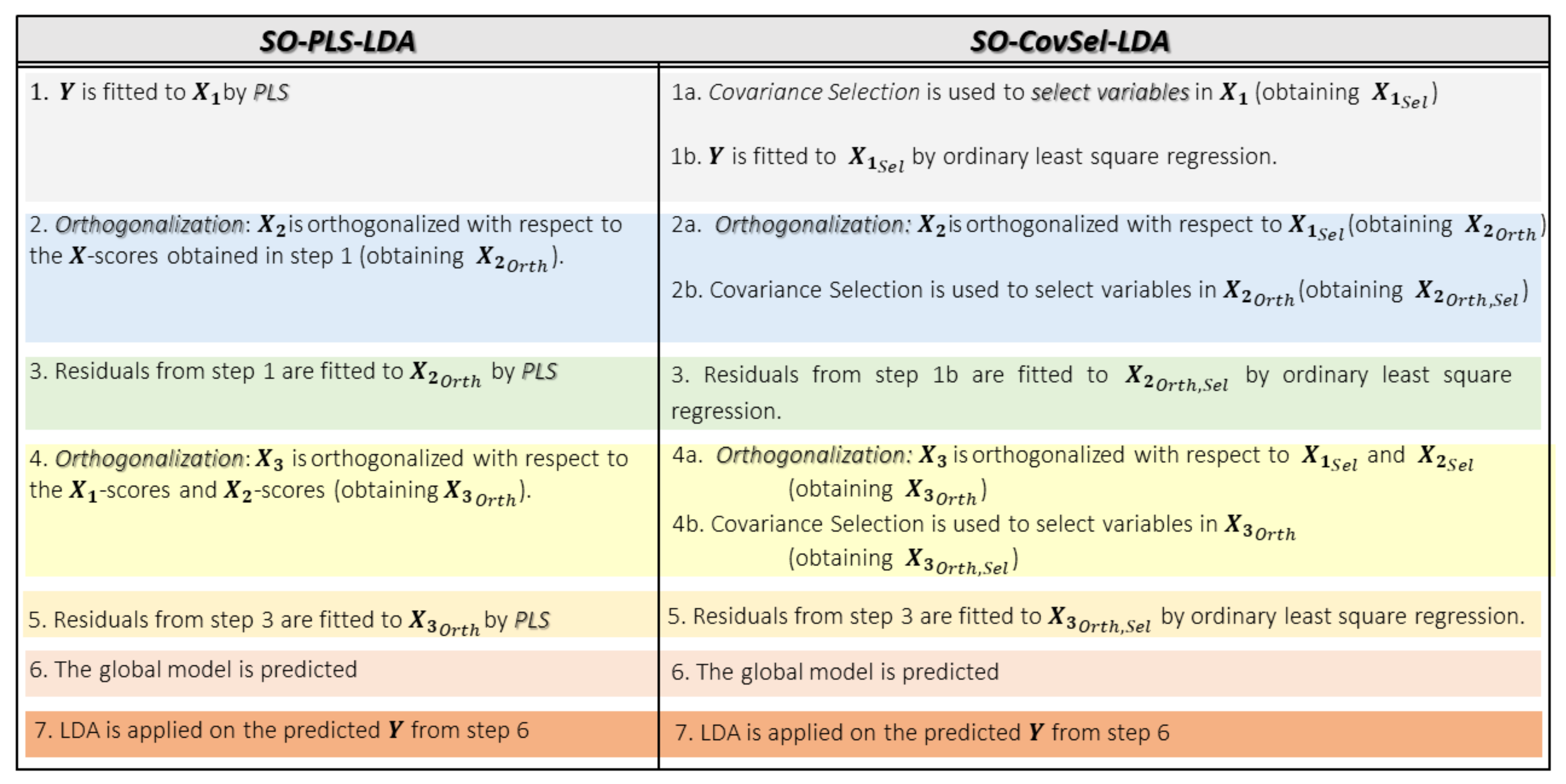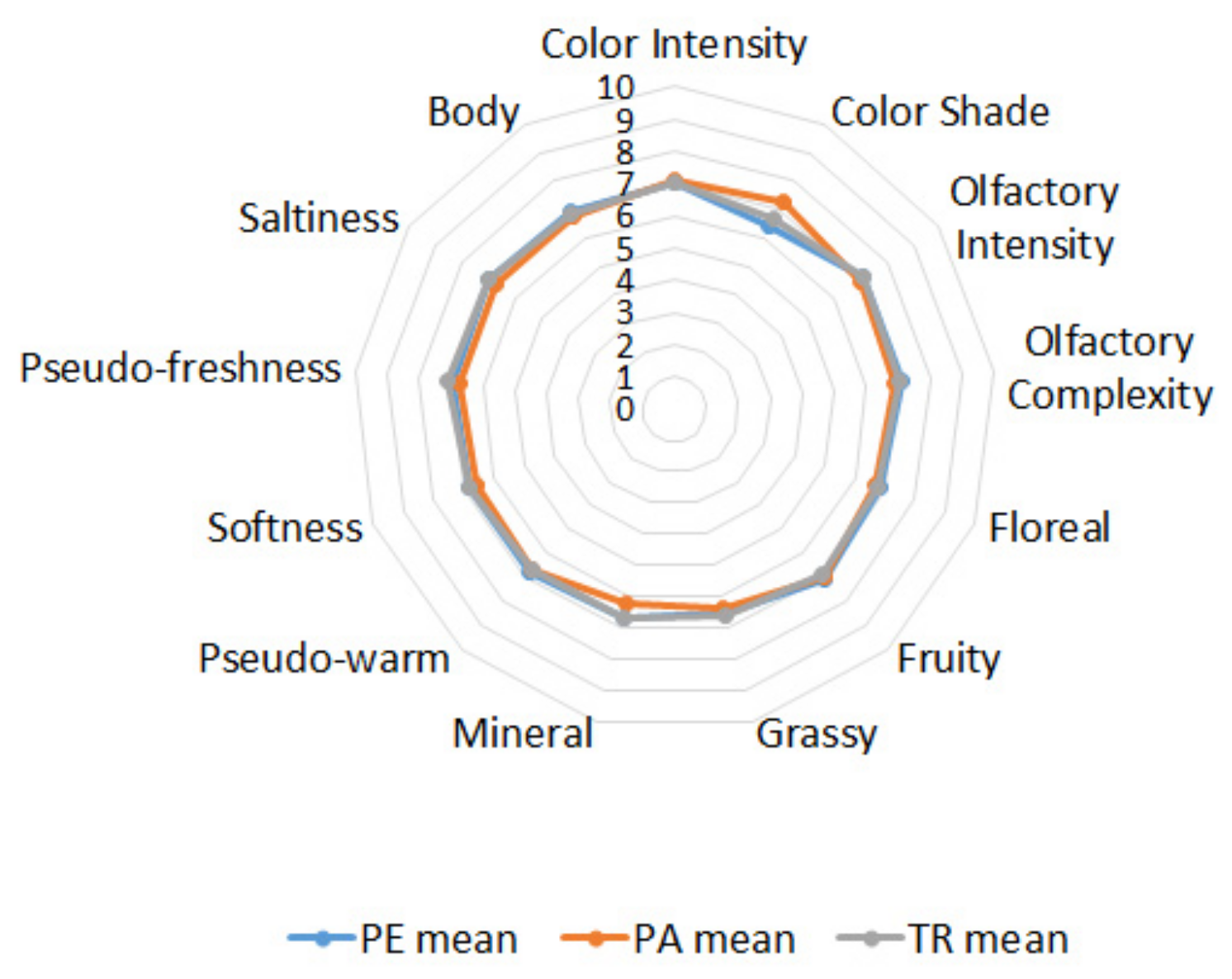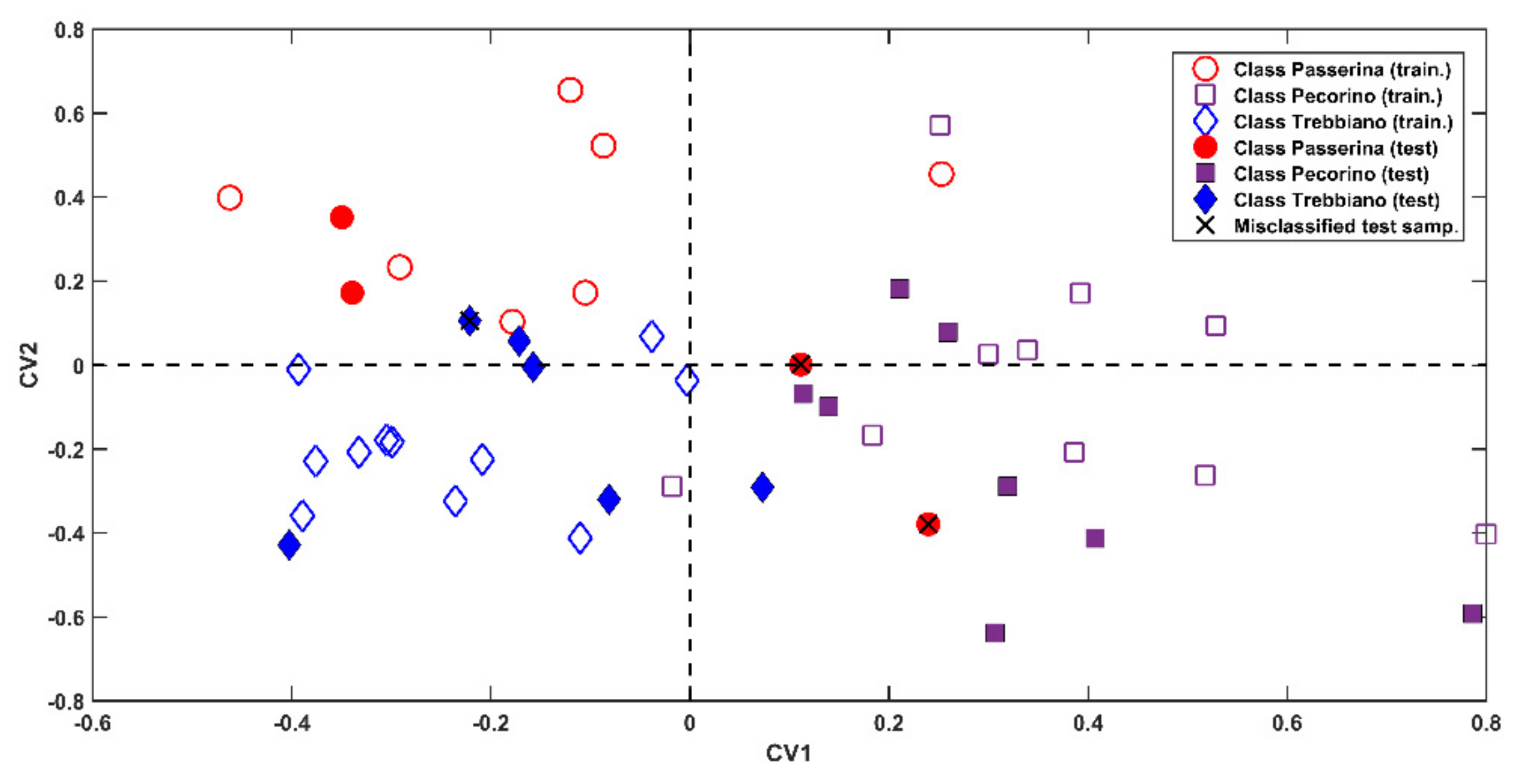Varietal Discrimination of Trebbiano d’Abruzzo, Pecorino and Passerina White Wines Produced in Abruzzo (Italy) by Sensory Analysis and Multi-Block Classification Based on Volatiles, Organic Acids, Polyphenols, and Major Elements
Abstract
:1. Introduction
2. Materials and Methods
2.1. Wine Samples
2.2. Sensory Analysis
2.3. Chemicals and Materials
2.4. Headspace Solid-Phase Micro-Extraction (HS-SPME) of Wine Volatiles
2.5. GC–MS Analysis of Volatile Profile
2.6. UHPLC Analysis of Organic Acids and Polyphenols
2.7. Multivariate Statistical Analysis
2.8. Multi-Block Classifiers
3. Results and Discussion
3.1. Sensory Analysis
3.2. Characterization of Wines by HS-SPME/GC–MS, UHPLC and ICP-OES
3.3. Single- and Multi-Block Varietal Classification
4. Conclusions
Supplementary Materials
Author Contributions
Funding
Institutional Review Board Statement
Informed Consent Statement
Acknowledgments
Conflicts of Interest
Appendix A
- (1)
- We noticed a certain uniformity on the descriptors found, with the only exception of the intensity and shade of color and mineral character. Prevailing were yellow flowers, ripe fruit and minerals.
- (2)
- Yellow flowers and ripe fruit indicate mature wines; in fact, the wines were quite evolved.
- (3)
- Regarding the vegetable, we can point out, within the descriptors, the one most highlighted at every single tasting: in almost all cases it was aromatic grass, being fresh grass just once.
- (4)
- Identifications, when indicated: chamomile and broom among the flowers, peach, apricot, and pineapple among the fruits; gentian among the aromatic herbs.
- (5)
- Compared to Pecorino and Trebbiano, Passerina seems less complex in the olfactory analysis, but this depends probably on a scarce acidity.
- (6)
- The three Passerina samples examined showed an olfactory component based on fruity and floral notes with a light vegetable trace.
- (7)
- The taste component showed average and rather uniform values of the various sensations, without any particular prominence.
- (8)
- The sensory characteristics detected are not perfectly in line with the typological characteristics of Passerina wine, but this may depend on the fact that the wines were tasted when they were beyond the optimal ripening. As already pointed out, the scarce acidity penalizes, in addition to the olfaction, the evaluation of all the other sensory components.
- (1)
- Pecorino wine samples are distinguished by a fresh olfactory-taste and aromatic profile, which demonstrates a relevant acidity. This means that wines are better preserved over time and when tasted, they were still perfectly healthy.
- (2)
- White flowers are not always described. The most frequent recognition, even if reported only by a few tasters in every wine, is jasmine.
- (3)
- The type of fruit that is most often found are citrus fruits in a generic sense, grapefruit in particular. Pineapple was also detected several times and, less frequently, apple.
- (4)
- The minerality has been detected.
- (5)
- An important aromatic profile can be noted: the individual values of the sensations detected stand on medium-high values.
- (6)
- The wines have an important sapidity.
- (7)
- The most relevant differences showed in the graphs are related to color intensity and shade, mineral, and saltiness notes.
- (1)
- Yellow flowers prevail over white flowers, ripe fruit over fresh fruit, aromatic herb over fresh grass. Taken together, however, these notes show that Trebbiano wines were tasted in a phase in which either the characteristics of maturity or youngness were still both perceptible.
- (2)
- Trebbiano samples demonstrated balanced olfactory and olfactory-taste characteristics.
- (3)
- The wine samples showed a fruity and floral olfactory component more important than the mineral component.
- (4)
- The aromatic complexity is fair.
- (5)
- In the gustatory component, the pseudo-freshness stands out above the others.
- (6)
- The sensory characteristics of the Trebbiano wines tasted were in line with the typological characteristics of a Trebbiano wine of medium longevity.
- (7)
- The graphs showed very homogeneous values except for the color shade.
References
- Pietrangeli, F.; Odoardi, M. L’Abruzzo Della Vite e del Vino; Menabò Srl: Ortona, Italy, 2017. [Google Scholar]
- Villano, C.; Lisanti, M.T.; Gambuti, A.; Vecchio, R.; Moio, L.; Frusciante, L.; Aversano, R.; Carputo, D. Wine varietal authentication based on phenolics, volatiles and DNA markers: State of the art, perspectives and drawbacks. Food Control 2017, 80, 1–10. [Google Scholar] [CrossRef]
- Holmberg, L. Wine fraud. Int. J. Wine Res. 2010, 2, 105–113. [Google Scholar] [CrossRef]
- Versari, A.; Laurie, V.F.; Ricci, A.; Laghi, L.; Parpinello, G.P. Progress in authentication, typification and traceability of grapes and wines by chemometric approaches. Food Res. Int. 2014, 60, 2–18. [Google Scholar] [CrossRef]
- Valentin, L.; Barroso, L.P.; Barbosa, R.M.; de Paulo, G.A.; Castro, I.A. Chemical typicality of South American red wines classified according to their volatile and phenolic compounds using multivariate analysis. Food Chem. 2020, 302, 125340. [Google Scholar] [CrossRef]
- Milovanovic, M.; Žeravík, J.; Obořil, M.; Pelcová, M.; Lacina, K.; Cakar, U.; Petrovic, A.; Glatz, Z.; Skládal, P. A novel method for classification of wine based on organic acids. Food Chem. 2019, 284, 296–302. [Google Scholar] [CrossRef]
- Pérez-Álvarez, E.P.; Garcia, R.; Barrulas, P.; Dias, C.; Cabrita, M.J.; Garde-Cerdán, T. Classification of wines according to several factors by ICP-MS multi-element analysis. Food Chem. 2019, 270, 273–280. [Google Scholar] [CrossRef]
- Bronzi, B.; Brilli, C.; Beone, G.M.; Fontanella, M.C.; Ballabio, D.; Todeschini, R.; Consonni, V.; Grisoni, F.; Parri, F.; Buscema, M. Geographical identification of Chianti red wine based on ICP-MS element composition. Food Chem. 2020, 315, 126248. [Google Scholar] [CrossRef]
- Epova, E.N.; Bérail, S.; Séby, F.; Barre, J.P.G.; Vacchina, V.; Médina, B.; Sarthou, L.; Donard, O.F.X. Potential of lead elemental and isotopic signatures for authenticity and geographical origin of Bordeaux wines. Food Chem. 2020, 303, 125277. [Google Scholar] [CrossRef]
- Chandra, S.; Chapman, J.; Power, A.; Roberts, J.; Cozzolino, D. Origin and Regionality of Wines—The Role of Molecular Spectroscopy. Food Anal. Methods 2017, 10, 3947–3955. [Google Scholar] [CrossRef]
- Gougeon, L.; da Costa, G.; Guyon, F.; Richard, T. 1H NMR metabolomics applied to Bordeaux red wines. Food Chem. 2019, 301, 125257. [Google Scholar] [CrossRef]
- Mascellani, A.; Hoca, G.; Babisz, M.; Krska, P.; Kloucek, P.; Havlik, J. 1H NMR chemometric models for classification of Czech wine type and variety. Food Chem. 2021, 339, 127852. [Google Scholar] [CrossRef]
- Cozzolino, D. Metabolomics in Grape and Wine: Definition, Current Status and Future Prospects. Food Anal. Methods 2016, 9, 2986–2997. [Google Scholar] [CrossRef]
- Saurina, J. Characterization of wines using compositional profiles and chemometrics. TrAC Trends Anal. Chem. 2010, 29, 234–245. [Google Scholar] [CrossRef]
- Biancolillo, A.; Boqué, R.; Cocchi, M.; Marini, F. Data Fusion Strategies in Food Analysis. In Data Fusion Methodology and Applications; Cocchi, M., Ed.; Elsevier: Amsterdam, The Netherlands, 2019; Volume 31, pp. 271–310. [Google Scholar]
- Crook, A.A.; Zamora-Olivares, D.; Bhinderwala, F.; Woods, J.; Winkler, M.; Rivera, S.; Shannon, C.E.; Wagner, H.R.; Zhuang, D.L.; Lynch, J.E.; et al. Combination of two analytical techniques improves wine classification by Vineyard, Region, and vintage. Food Chem. 2021, 354, 129531. [Google Scholar] [CrossRef]
- Mazerolles, G.; Preys, S.; Bouchut, C.; Meudec, E.; Fulcrand, H.; Souquet, J.M.; Cheynier, V. Combination of several mass spectrometry ionization modes: A multiblock analysis for a rapid characterization of the red wine polyphenolic composition. Anal. Chim. Acta 2010, 678, 195–202. [Google Scholar] [CrossRef]
- Ríos-Reina, R.; Azcarate, S.M.; Camiña, J.M.; Goicoechea, H.C. Multi-level data fusion strategies for modeling three-way electrophoresis capillary and fluorescence arrays enhancing geographical and grape variety classification of wines. Anal. Chim. Acta 2020, 1126, 52–62. [Google Scholar] [CrossRef]
- Silvestri, M.; Bertacchini, L.; Durante, C.; Marchetti, A.; Salvatore, E.; Cocchi, M. Application of data fusion techniques to direct geographical traceability indicators. Anal. Chim. Acta 2013, 769, 1–9. [Google Scholar] [CrossRef]
- Silvestri, M.; Elia, A.; Bertelli, D.; Salvatore, E.; Durante, C.; Li Vigni, M.; Marchetti, A.; Cocchi, M. A mid level data fusion strategy for the Varietal Classification of Lambrusco PDO wines. Chemom. Intell. Lab. Syst. 2014, 137, 181–189. [Google Scholar] [CrossRef]
- Tan, J.; Li, R.; Jiang, Z.T.; Zhang, Y.; Hou, Y.M.; Wang, Y.R.; Wu, X.; Gong, L. Geographical classification of Chinese Cabernet Sauvignon wines by data fusion of ultraviolet–visible and synchronous fluorescence spectroscopies: The combined use of multiple wavelength differences. Aust. J. Grape Wine Res. 2016, 22, 358–365. [Google Scholar] [CrossRef]
- Ruggieri, F.; D’Archivio, A.A.; Foschi, M.; Maggi, M.A. Multivariate optimization of an analytical method for the analysis of Abruzzo white wines by ICP OES. Anal. Methods 2020, 12, 2772–2778. [Google Scholar] [CrossRef]
- Biancolillo, A.; Måge, I.; Næs, T. Combining SO-PLS and linear discriminant analysis for multi-block classification. Chemom. Intell. Lab. Syst. 2015, 141, 58–67. [Google Scholar] [CrossRef]
- Biancolillo, A.; Marini, F.; Roger, J.-M. SO-CovSel: A novel method for variable selection in a multiblock framework. J. Chemom. 2020, 34, e3120. [Google Scholar] [CrossRef]
- ISO 8589 2007; Sensory Analysis. General Guidance for the Design of the Test Rooms. International Organization for Standardization: Geneva, Switzerland, 2007.
- ISO 3591 1977; Sensory Analysis. Apparatus Wine Tasting Glass. International Organization for Standardization: Geneva, Switzerland, 1977.
- Ståhle, L.; Wold, S. Partial least squares analysis with cross-validation for the two-class problem: A Monte Carlo study. J. Chemom. 1987, 1, 185–196. [Google Scholar] [CrossRef]
- Barker, M.; Rayens, W. Partial least squares for discrimination. J. Chemom. 2003, 17, 166–173. [Google Scholar] [CrossRef]
- Biancolillo, A.; Næs, T. The Sequential and Orthogonalized PLS Regression for Multiblock Regression: Theory, Examples, and Extensions. In Data Fusion Methodology and Applications; Cocchi, M., Ed.; Elsevier: Amsterdam, The Netherlands, 2019; Volume 31, pp. 157–177. [Google Scholar]
- Han, S.; Yang, J.; Choi, K.; Kim, J.; Adhikari, K.; Lee, J. Chemical Analysis of Commercial White Wines and Its Relationship with Consumer Acceptability. Foods 2022, 11, 603. [Google Scholar] [CrossRef]
- Karabagias, I.K.; Karabagias, V.K.; Badeka, A. V Volatilome of white wines as an indicator of authenticity and adulteration control using statistical analysis. Aust. J. Grape Wine Res. 2021, 27, 269–279. [Google Scholar] [CrossRef]
- Gajek, M.; Pawlaczyk, A.; Szynkowska-Jozwik, M.I. Multi-Elemental Analysis of Wine Samples in Relation to Their Type, Origin, and Grape Variety. Molecules 2021, 26, 214. [Google Scholar] [CrossRef]
- Drava, G.; Minganti, V. Mineral composition of organic and conventional white wines from Italy. Heliyon 2019, 5, e02464. [Google Scholar] [CrossRef]
- Titarenko, V.O.; Khalafyan, A.A.; Temerdashev, Z.A.; Kaunova, A.A.; Ivanovets, E.A. Application of Statistical Methods for Classification of Varietal and Regional Origin of White Wines. Inorg. Mater. 2018, 54, 1435–1442. [Google Scholar] [CrossRef]
- Snee, R.D. Validation of Regression Models: Methods and Examples. Technometrics 1977, 19, 415–428. [Google Scholar] [CrossRef]
- Firmani, P.; Nardecchia, A.; Nocente, F.; Gazza, L.; Marini, F.; Biancolillo, A. Multi-block classification of Italian semolina based on Near Infrared Spectroscopy (NIR) analysis and alveographic indices. Food Chem. 2020, 309, 125677. [Google Scholar] [CrossRef]
- Dieterle, F.; Ross, A.; Schlotterbeck, G.; Senn, H. Probabilistic quotient normalization as robust method to account for dilution of complex biological mixtures. Application in 1H NMR metabonomics. Anal. Chem. 2006, 78, 4281–4290. [Google Scholar] [CrossRef]
- Krzanowski, W. Principles of Multivariate Analysis, 2nd ed.; Oxford University Press: Oxford, UK, 2000. [Google Scholar]
- Wold, S.; Johansson, E.; Cocchi, M. PLS-partial least-squares projections to latent structures. In 3D QSAR Drug Design; KLUWER ESCOM Science Publisher: Alphen aan den Rijn, The Netherlands, 1993; pp. 523–550. [Google Scholar]
- Ivanova-Petropulos, V.; Petruševa, D.; Mitrev, S. Rapid and Simple Method for Determination of Target Organic Acids in Wine Using HPLC-DAD Analysis. Food Anal. Methods 2020, 13, 1078–1087. [Google Scholar] [CrossRef]
- Welke, J.E.; Nicolli, K.P.; Hernandes, K.C.; Biasoto, A.C.T.; Zini, C.A. Adaptation of an olfactometric system in a GC-FID in combination with GCxGC/MS to evaluate odor-active compounds of wine. Food Chem. 2022, 370, 131004. [Google Scholar] [CrossRef]
- Dutra, S.V.; Adami, L.; Marcon, A.R.; Carnieli, G.J.; Roani, C.A.; Spinelli, F.R.; Leonardelli, S.; Ducatti, C.; Moreira, M.Z.; Vanderlinde, R. Determination of the geographical origin of Brazilian wines by isotope and mineral analysis. Anal. Bioanal. Chem. 2011, 401, 1575–1580. [Google Scholar]





| Training Set (n. Samples) | Test Set (n. Samples) | ||||||
|---|---|---|---|---|---|---|---|
| Passerina | Pecorino | Trebbiano | Tot. | Passerina | Pecorino | Trebbiano | Tot. |
| 7 | 10 | 11 | 28 | 4 | 8 | 6 | 18 |
| Data Block | Pretreatment | LVs | Average Classification Error Rate (CV) |
|---|---|---|---|
| UHPLC | Mean-Centering (MC) | 5 | 0.41 |
| AutoScaling | 2 | 0.42 | |
| PQN (+MC) | 8 | 0.43 | |
| ICP-OES | Mean-Centering (MC) | 5 | 0.34 |
| AutoScaling | 4 | 0.31 | |
| PQN (+MC) | 8 | 0.29 | |
| Log10 | 7 | 0.28 | |
| GC | Mean-Centering (MC) | 6 | 0.43 |
| AutoScaling | 1 | 0.49 | |
| PQN (+MC) | 5 | 0.48 |
| Classifier |
LVs | Classification Rates (External Set) | ||
|---|---|---|---|---|
| Class Passerina | Class Pecorino | Class Trebbiano | ||
| SO-PLS-LDA | 1,4,1 | 50.0 | 100.0 | 83.3 |
| SO-CovSel-LDA | 5,7,1 | 75.0 | 87.5 | 66.6 |
Publisher’s Note: MDPI stays neutral with regard to jurisdictional claims in published maps and institutional affiliations. |
© 2022 by the authors. Licensee MDPI, Basel, Switzerland. This article is an open access article distributed under the terms and conditions of the Creative Commons Attribution (CC BY) license (https://creativecommons.org/licenses/by/4.0/).
Share and Cite
Biancolillo, A.; D’Archivio, A.A.; Pietrangeli, F.; Cesarone, G.; Ruggieri, F.; Foschi, M.; Reale, S.; Rossi, L.; Crucianelli, M. Varietal Discrimination of Trebbiano d’Abruzzo, Pecorino and Passerina White Wines Produced in Abruzzo (Italy) by Sensory Analysis and Multi-Block Classification Based on Volatiles, Organic Acids, Polyphenols, and Major Elements. Appl. Sci. 2022, 12, 9794. https://doi.org/10.3390/app12199794
Biancolillo A, D’Archivio AA, Pietrangeli F, Cesarone G, Ruggieri F, Foschi M, Reale S, Rossi L, Crucianelli M. Varietal Discrimination of Trebbiano d’Abruzzo, Pecorino and Passerina White Wines Produced in Abruzzo (Italy) by Sensory Analysis and Multi-Block Classification Based on Volatiles, Organic Acids, Polyphenols, and Major Elements. Applied Sciences. 2022; 12(19):9794. https://doi.org/10.3390/app12199794
Chicago/Turabian StyleBiancolillo, Alessandra, Angelo Antonio D’Archivio, Fabio Pietrangeli, Gaia Cesarone, Fabrizio Ruggieri, Martina Foschi, Samantha Reale, Leucio Rossi, and Marcello Crucianelli. 2022. "Varietal Discrimination of Trebbiano d’Abruzzo, Pecorino and Passerina White Wines Produced in Abruzzo (Italy) by Sensory Analysis and Multi-Block Classification Based on Volatiles, Organic Acids, Polyphenols, and Major Elements" Applied Sciences 12, no. 19: 9794. https://doi.org/10.3390/app12199794
APA StyleBiancolillo, A., D’Archivio, A. A., Pietrangeli, F., Cesarone, G., Ruggieri, F., Foschi, M., Reale, S., Rossi, L., & Crucianelli, M. (2022). Varietal Discrimination of Trebbiano d’Abruzzo, Pecorino and Passerina White Wines Produced in Abruzzo (Italy) by Sensory Analysis and Multi-Block Classification Based on Volatiles, Organic Acids, Polyphenols, and Major Elements. Applied Sciences, 12(19), 9794. https://doi.org/10.3390/app12199794











